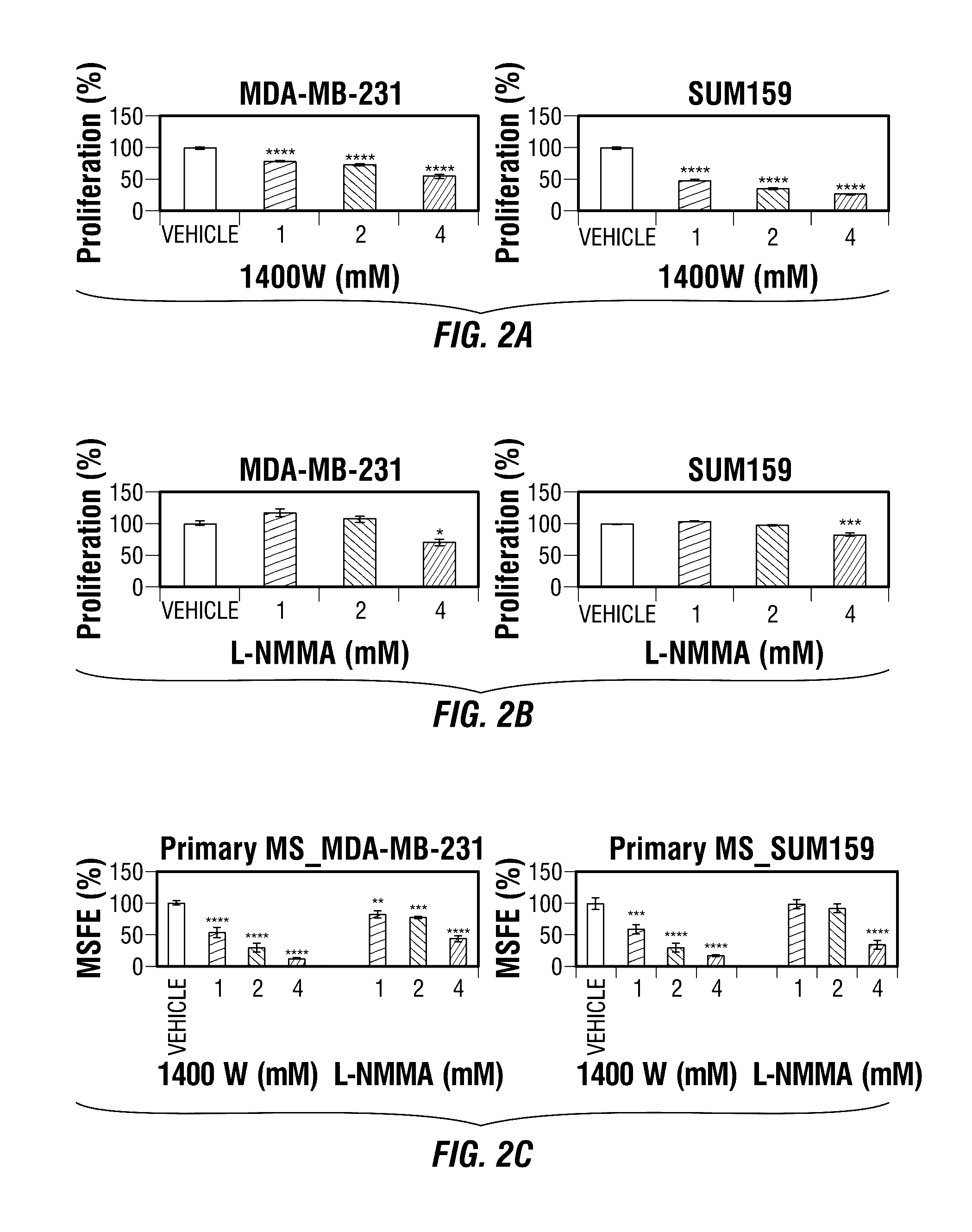Inos-inhibitory compositions and their use as breast cancer therapeutics
a composition and inhibitor technology, applied in the field of medicine and oncology, can solve the problems of limited progress in the treatment of advanced breast cancer, little change in the overall survival, and intratumoral heterogeneity
- Summary
- Abstract
- Description
- Claims
- Application Information
AI Technical Summary
Benefits of technology
Problems solved by technology
Method used
Image
Examples
example 1
iNOS Inhibition as an Effective Targeted Therapy Against TNBC
[0238]As noted above, TNBC is an aggressive form of breast cancer with no effective targeted therapy. iNOS is associated with poor survival in breast cancer patients by increasing tumor aggressiveness. It was hypothesized that inhibition of endogenous iNOS would decrease TNBC aggressiveness by reducing tumor initiation and metastasis through modulation of epithelial-mesenchymal transition (EMT)-inducing factors.
[0239]This example describes the use of iNOS inhibitors as a targeted therapy for TNBC. iNOS protein levels were determined in 83 human TNBC tissue and correlated with clinical outcome. Proliferation, mammosphere-forming efficiency, migration, EMT transcription factors were assessed in vitro after iNOS inhibition. Endogenous iNOS targeting was evaluated as potential therapy in TNBC mouse models.
[0240]High endogenous iNOS expression was associated with worse prognosis in TNBC patients by gene expression as well as im...
example 2
Effects of Calcium Channel Antagonists
[0313]Materials and Methods
[0314]Cell Proliferation Assay In Vitro.
[0315]Mesenchymal-like, TNBC cell lines, MDA-MB-231 and SUM159, were grown in DMEM supplemented with 10% fetal bovine serum and 1% antibiotic-antimycotic. Stock solutions of various calcium-channel antagonists (amlodipine, nicardipine, nifedipine, felodipine, isradipine, diltiazem, verapamil, lacidipine, nisoldipine, nitrendipine, nivaldipine, azelnidipine, barnidipine, benidipine, efonidipine, lercanidipine, pranidipine, and manidipine) were prepared in DMSO. Effects on cell proliferation were assayed with the WST-1 method. Briefly, 1,000 (SUM159) and 2,000 (MDA-MB-231) cells / well were plated in a 96-well plate and treated with different concentrations (0, 1, 5, and 10 μM) of calcium channel antagonists for 72 hrs. Proliferation rate was determined by adding premixed WST-1 reagent. After incubation at 37° C. for three hrs, absorbance was read at 450 nm (reference wavelength 690 ...
PUM
| Property | Measurement | Unit |
|---|---|---|
| Power | aaaaa | aaaaa |
| Electrical resistance | aaaaa | aaaaa |
| Cytotoxicity | aaaaa | aaaaa |
Abstract
Description
Claims
Application Information
 Login to View More
Login to View More - R&D
- Intellectual Property
- Life Sciences
- Materials
- Tech Scout
- Unparalleled Data Quality
- Higher Quality Content
- 60% Fewer Hallucinations
Browse by: Latest US Patents, China's latest patents, Technical Efficacy Thesaurus, Application Domain, Technology Topic, Popular Technical Reports.
© 2025 PatSnap. All rights reserved.Legal|Privacy policy|Modern Slavery Act Transparency Statement|Sitemap|About US| Contact US: help@patsnap.com



